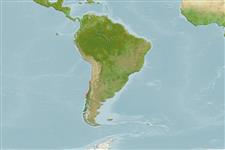Malacostraca |
Decapoda |
Pandalidae
Environment: milieu / climate zone / depth range / distribution range
Ecology
Benthic; depth range 155 - 424 m (Ref. 8). Subtropical, preferred 14°C (Ref. 107945); 25°S - 39°S (Ref. 8)
Southeast Pacific: Chile.
Length at first maturity / Size / Weight / Age
Maturity: Lm 2.5 range ? - ? cm Max length : 3.4 cm CL male/unsexed; (Ref. 8); 3.9 cm CL (female)
Prefers clay, mud or sandy mud bottoms (Ref. 8).
Life cycle and mating behavior
Maturity | Reproduction | Spawning | Eggs | Fecundity | Larvae
Members of the order Decapoda are mostly gonochoric. Mating behavior: Precopulatory courtship ritual is common (through olfactory and tactile cues); usually indirect sperm transfer.
Holthuis, L.B. 1980 FAO Species Catalogue. Vol. 1. Shrimps and prawns of the world. An annotated catalogue of species of interest to fisheries. FAO Fish. Synop. 125(1):271 p. Rome: FAO. (Ref. 8)
IUCN Red List Status
(Ref. 130435: Version 2025-1)
CITES status (Ref. 108899)
Not Evaluated
Not Evaluated
Threat to humans
Human uses
Fisheries: commercial
FAO - Fisheries: landings, species profile | FishSource | Sea Around Us
Tools
More information
Trophic EcologyFood items (preys)Diet compositionFood consumptionPredators PhysiologyOxygen consumption
Human RelatedStamps, coins, misc.
Internet sources
Estimates based on models
Preferred temperature
(Ref.
115969): 9.3 - 10.7, mean 10.2 (based on 3 cells).
Resilience
Medium, minimum population doubling time 1.4 - 4.4 years (K=0.14-0.2).
Fishing Vulnerability
Moderate vulnerability (37 of 100).
Climate Vulnerability
High vulnerability (61 of 100).
Nutrients : Calcium = 109 [35, 184] mg/100g; Iron = 1.59 [1.21, 1.97] mg/100g; Protein = 20.2 [19.2, 21.3] %; Omega3 = 0.285 [0.185, 0.386] g/100g; Selenium = 48.3 [-31.7, 128.3] μg/100g; VitaminA = 0 μg/100g; Zinc = 1.79 [1.17, 2.40] mg/100g (wet weight); based on
nutrient studies.
